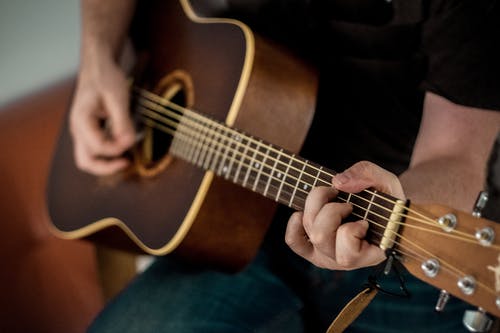Playing Triplet Rhythms on Guitar:
A Quick Guide
Music is free and doesn’t always adapt to the steady eight-not or quarter-note pulse that defines most time signatures. Whenever guitar players wish to add rhythmic variety to a passage, they can use a type of note value called tuplet.
The most common tuplet in music of different genres is the triplet. In this post, we’ll discuss what you need to know about triplets to enhance your guitar playing.
What is a triplet?
When you divide a beat by 3, you get a triplet. Compared to the normal eight notes in which you divide a beat into two, there’s a different feel when you play triplets. In music theory, they’re a three-note pattern that occupies the duration of a two-note pattern.
In a triplet, each note has an equal rhythmic value. Below are three common examples:
- Quarter Note Triplet
This consists of three-quarter notes over the same amount of time as a single half-note or two-quarter notes.
- Eighth Note Triplet
This contains three eighth notes in the space usually occupied by a single quarter note or two eighth notes.
- Sixteenth Note Triplet
This contains three sixteenth notes over the span of a single eighth note or two sixteenth notes.
A single triplet can already instill complex rhythm into a plain musical phrase. Repeating triplet rhythms can create an effect of compound meters, particularly when a composer pair a triplet rhythm with a steady eighth-note pulse or quarter note.
Counting and Playing Triplets
To properly execute and play a triplet pattern on your guitar, you need first to know how to count and play triplet rhythms. You have to treat all three notes as an equal part of a whole. Don’t give too much emphasis on the first note to avoid producing wrong sounds.
For instance, you’re playing a set of half-note triplets where you sustain the first note too long, you’ll end up sounding like two dotted quarter notes followed by a regular quarter note. While this seems to have a great rhythm in itself, it’s not a half-note triplet. Try using a metronome to make sure that you’re playing all three triplet notes at the same length.
Count Notes As You Play
For a beginner guitar player, a triplet may feel like an irrational rhythm. If you want the process to feel natural, try counting the notes as you play.
Begin by counting an ordinary eighth note triplet as one-and-two and three-and-four-and. Then, do the same thing to count three pulses of a triplet by mouthing “tri-pa-let” as you play — for example, one-and-two and tri-pa-let-four-and. With constant practice, hearing the sound of triplets in your head will become natural, and you’ll be playing them fluidly without mouthing the syllables.
Tips for Playing Triplet Rhythms
So, do you want to enhance your guitar strumming, solos, or compositions by adding triplets? If you don’t know where to begin, these four tips may be able to help.
1. Get Familiar with the Sound
Before you start playing triplets on the guitar, you have to understand what’s going on. Try to listen a few times to a music passage with triplets to get familiar with the sound. After you’ve has enough, try to play the whole music on your guitar while following the picking suggestions.
Once you grasp it, play it with a metronome, then gradually increase the tempo.
2. Practice Guitar Picking Technique
You have to work through your picking technique and feel using single notes and chords before playing a triplet rhythm. Triplets hold great potential in cultivating feel and exciting lead lines. When you play through, a general rule to execute triplets is to use alternate picking, such as:
- Downstroke, upstroke, and downstroke
- For fingerstyle: thumb, index, and middle fingers.
As you practice guitar picking techniques, you want to feel the typical “strong-weak-weak ” rhythmic signature pattern of sounding a triplet.
3. Improve Hand Synchronization
When playing the guitar, it takes two to tango. In this case, your left hand should have the necessary agility across the fretboard and work synchronously with your picking hand. Both hands must work in harmony so that you hit each string at the exact time to produce clear notes.
An important tip that can help with hand synchronization is limiting any large movements. As much as possible, keep your hand movements small and efficient. For accurate play of eighth-note triplets or quarter note triplets, keep your fingers and hand motions to only what’s necessary to play each note.
Tips To Make It Easier
- Keep fingertips close to the strings while playing to avoid hitting the wrong string.
- Instead of massive strums, aim for the smallest path for your picking hand.
4. Try Varied Rhythmic Subdivisions
You’re already taking the time to practice and improve your guitar skills, so why not go out of your comfort zone? Practicing different rhythmic subdivisions can add additional skills to your guitar tool kit.
You can go straight from eighth notes, to eighth note triplets, to sixteenth notes, then so on. Just remember to monitor your tension and playing style as you increase the speed and move along to another rhythmic subdivision.
If you experience increased tension, that’s completely natural. Just be keen on checking yourself from time to time and make adjustments.
Keep Learning
As you may have noticed, honing your guitar skills requires a combination of learning multiple techniques. Don’t lose hope and work on that quarter note beat or anything at all that’s giving you trouble.
Again, playing triplets will be tough for you at first. But continue to persevere, play through quarter notes, eighth notes, eighth note triplets, sixteenth notes, and work back down to quarter notes. Once you get comfortable, you’ll be more aware of the beat and be able to switch between subdivisions quickly. It sharpens your rhythm and sets you apart from other guitar players.

